Hello everyone! Welcome back to URR’s 0.11 updates :).
To begin with, let’s take stock. I think I’ll make this a thing at the start of each update from now on for this year and see how that goes. The colour-coding is going to be that GREEN is something I am now working on, BLUE is something done, and BLACK is something I haven’t yet started on. So, here’s where I am at the point of publishing this entry:
ITEM INTERACTIONS
- You can drop items
- You can pick items up
- You can use items (whatever that means for the item in question)
- You can destroy items (very rarely an item might have something hidden inside it…!)
- You can show items (e.g. to someone else)
RELIGIONS
- Generate the images for all 25+ archetypes of religious relics, and place them in religious buildings
- Update and transform things like religious beliefs, things religions dislike, information about religious histories, holy books, etc
- Enable the player to join and leave a religion
- Far more complex interactions with priests etc
- Develop proper model for “membership” in religions, nations, cults, etc
TREASURE MAPS
- Treasure maps spawn in shops just like non-treasure maps do
- Zoomed-out treasure maps correctly show relevant locations
- Zoomed-in treasure maps correctly show relevant locations (far more complex)
- High-value items are, indeed, under the ground where a map points!
- These will become, for now, the game’s primary objective (rather than, as they will be later, one aspect of many)
MORE OPTMIZATIONS / BUG FIXING / POLISHING
- I currently count 48 known bugs / issues – I want this down to 0
- Further speed up map generation
- Further speed up turn-by-turn rendering
- Try to speed up world generation as well?
So as you can see, quite a bit of new progress (those first blues) since last time, and also more progress has been done on the relics, and on bug-fixing, and on a few other minor things as well. So let’s get to it (and as ever, if you enjoy these blog entries, please do think about posting them online in places where others might be interested in them! These take a lot to write, so I really do appreciate it.)
Procedural relic generation
First off, let’s have some more procedural relic generation. I showed off a couple of the initial archetypes in the previous update and I’ve been hard at work on some more archetypes for other generated religious relics. As mentioned last time every religion in a game world will select a random archetype, and then within that each individual relic will itself be procedurally generated in terms of its image, and in terms of its name. The idea is both that each religion will be even more distinctive from the others than it previously was, and also that the player should be able to come to recognise relic archetypes as time goes by and have some idea who one might want to take a relic to in order to get a reward – or, perhaps, who one might want to keep a relic from in order to pursue some other agenda. For this week here are three new religious relic archetypes, and three examples of what can be generated from each. There are only a few thousand of the metal symbol archetype, but around a hundred thousand possible cogs, and well around one and a half million possible fans.

In turn each, of course, has a unique name generator. The symbol relics have names like “The Treasured Symbol of [Name]” or “The Etched Imprint of [Name]” where the “[Name]” part will be an appropriate name to the nation or nations the religion belongs to and will denote an important historical religious figure such as a prophet. The cog relics have names like “The Bronze Cogwheel of the Great Machine” or “The Pristine Gear of the Sacred Engine” – I have to admit I really like these, and they really evoke a very strange and esoretic religion to me that maybe in some way worships machinery and technology? The fans have names like “The Pearl Fan of Heaven” or “The Emerald Fan of Courage” and the colour-related word in the name will of course relate to the actual colour of the fan. Again, super happy with these, and so excited by how all these relics are coming together!
Item Interaction Choices
Last time I talked about some of the core item interaction options we need in the game and the system for keeping track of what options each item should have. I’ve been building on this massively this week and item-based interactions are absolutely zooming along! The game now starts off with four default options for every item you might do something with – “Destroy”, “drop”, “throw” and “present” (as noted in last week’s entry presenting an item in essence means showing it to the NPCs who are right next to you). These will be present for every single item, even if some are not easy to destroy (taking a long time), others are not easy to throw (they might be too heavy to throw more than a single tile), and others might be unwise to present to the wrong person (don’t go waving your battleaxe around the local monarch!). For items which have a specific use function the game then adds “use” into the list, where use can mean anything from putting a piece of clothing on, taking it off, drinking something in a bottle, wielding a weapon, quivering some arrows, putting on a necklace, using a pickaxe or shovel, etc etc. These options are then presented to the player when they look up an item, as shown here:
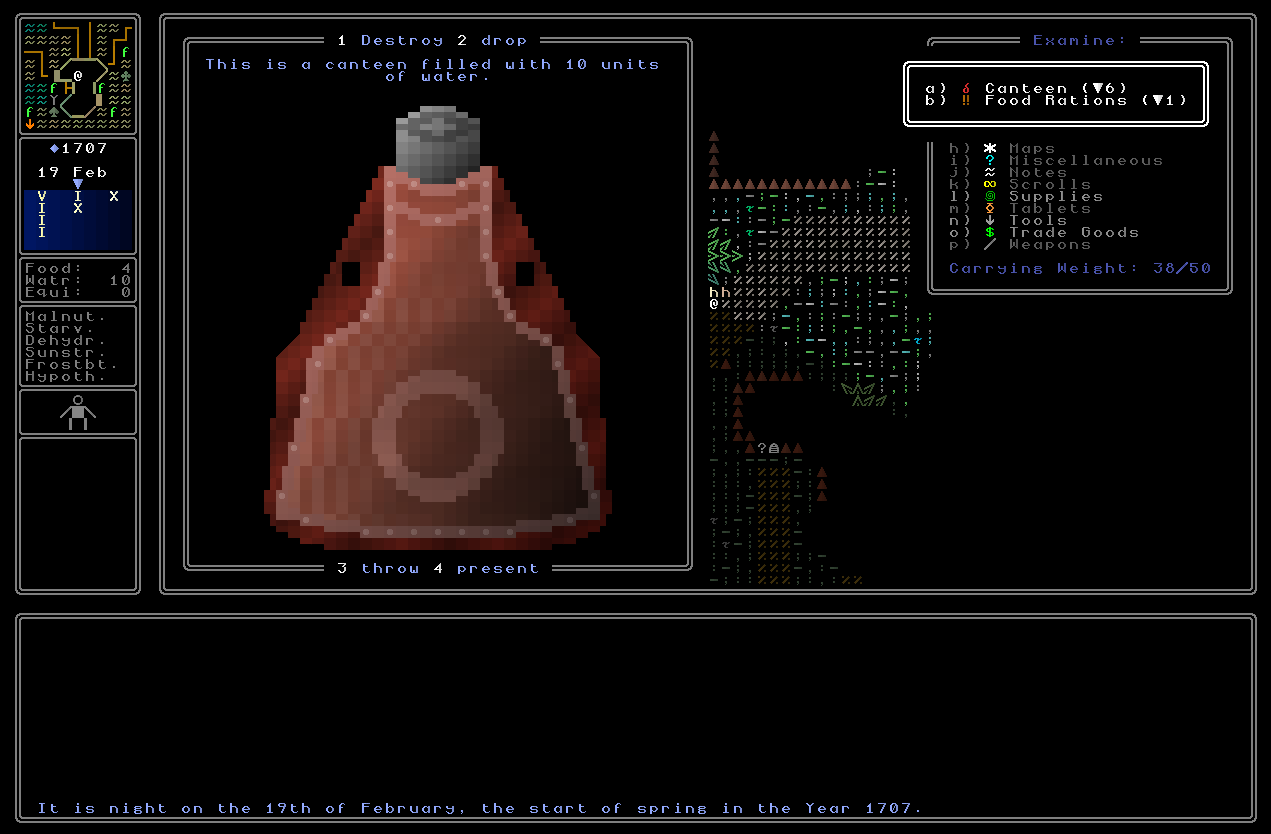
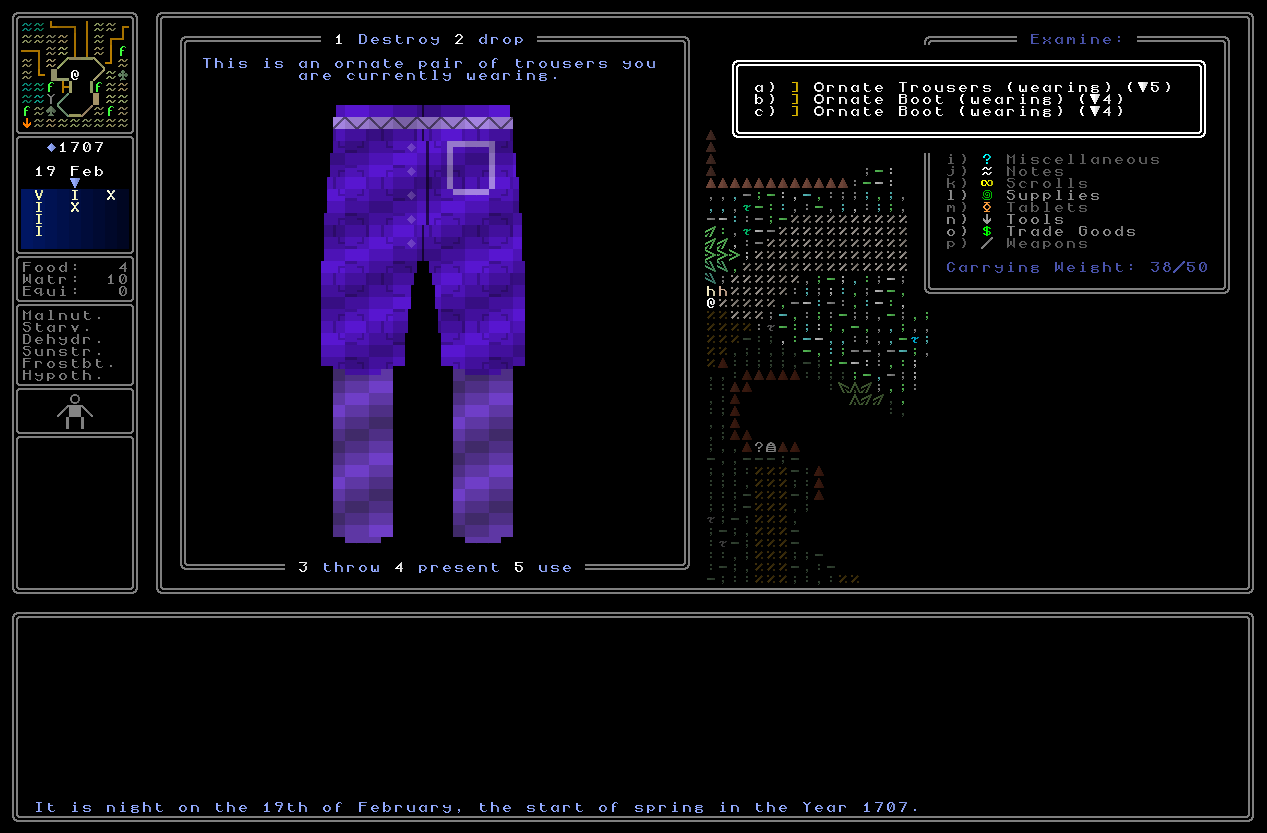
Pressing the number shown by each function will then do that thing! I couldn’t use the letters because – as you’ll note on the right-hand side – it is with letters that you navigate the inventory, so ‘d’ for instance could not be both ‘d’rop and ‘look at the fourth item in your inventory’ once you’re actually in the inventory. You will however also later be able to press ‘D’, ‘d’, ‘p’, ‘t’, or ‘u’ to go into your inventory with that function pre-selected; I think it makes sense to give the user both options, as sometimes you’ll probably want to browse your items before deciding what to do, while other times you’ll already know what needs doing but might not necessarily have the item already in mind. Right now it’s the former functionality (inventory and then action) which is implemented, but the latter will be following shortly behind.
Dropping and Picking Up
You can now drop and pick up items. This was implemented around half a decade ago but eventually wound up being taken out because it wasn’t actually necessary for the game at that time, and it ran into a number of realism problems – what if you just dropped all your clothes and ran around in the nude, for instance? NPCs should be responding but for many years there were no NPCs to respond, and then when there finally were NPCs, programming in responses to this kind of action were themselves fairly demanding and would have taken up a lot of time. However, with the world of URR now so complex and so full of detail, I can actually bring back these functions as part of massively increasing the interactivity of the game world for the player. The first of these is therefore dropping, which is one of the options in any item. Using it will place the item on the ground at the player’s feet (nothing will be smashed or destroyed by dropping, e.g. bottles) and the most recently dropped item will be the one that shows up at the top of a stack of dropped items.
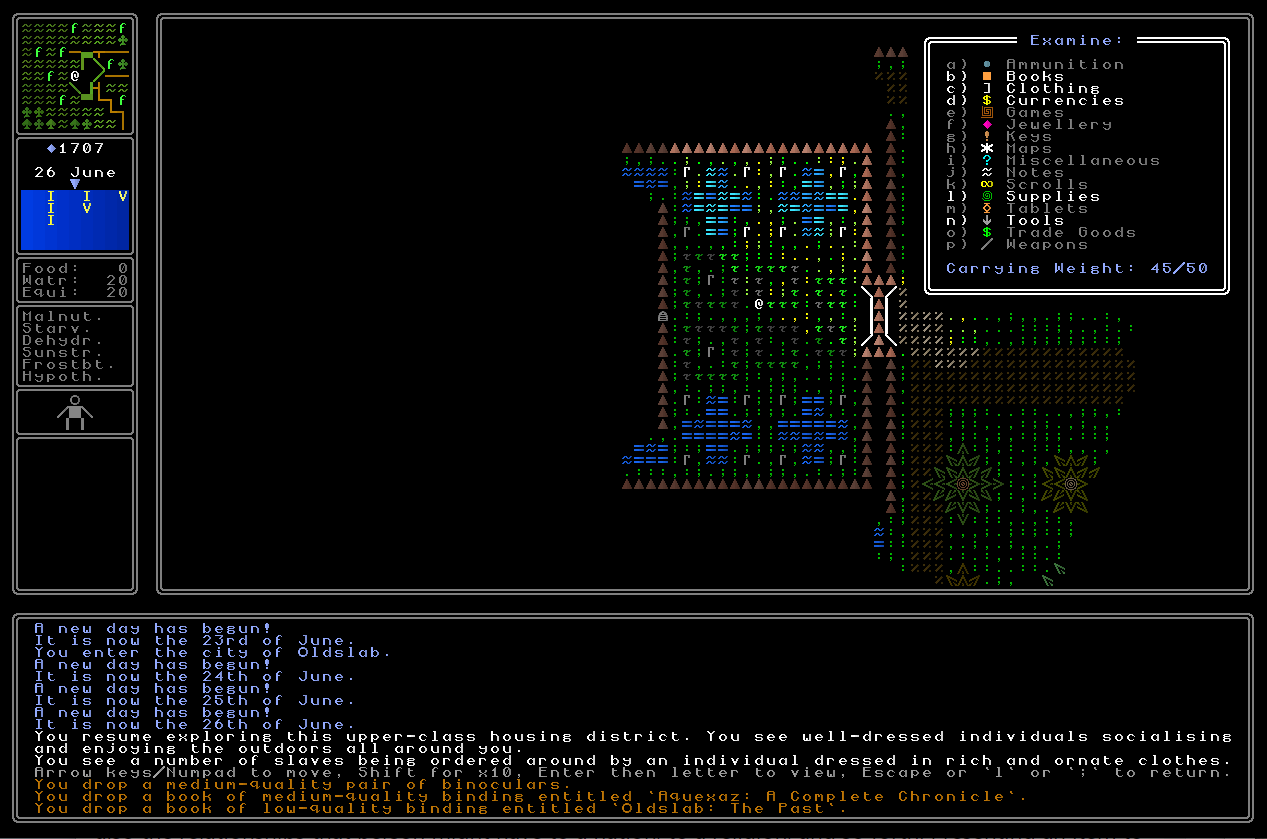
You can then of course take a look at the stack of items and you’ll see all the items which have stacked up here:
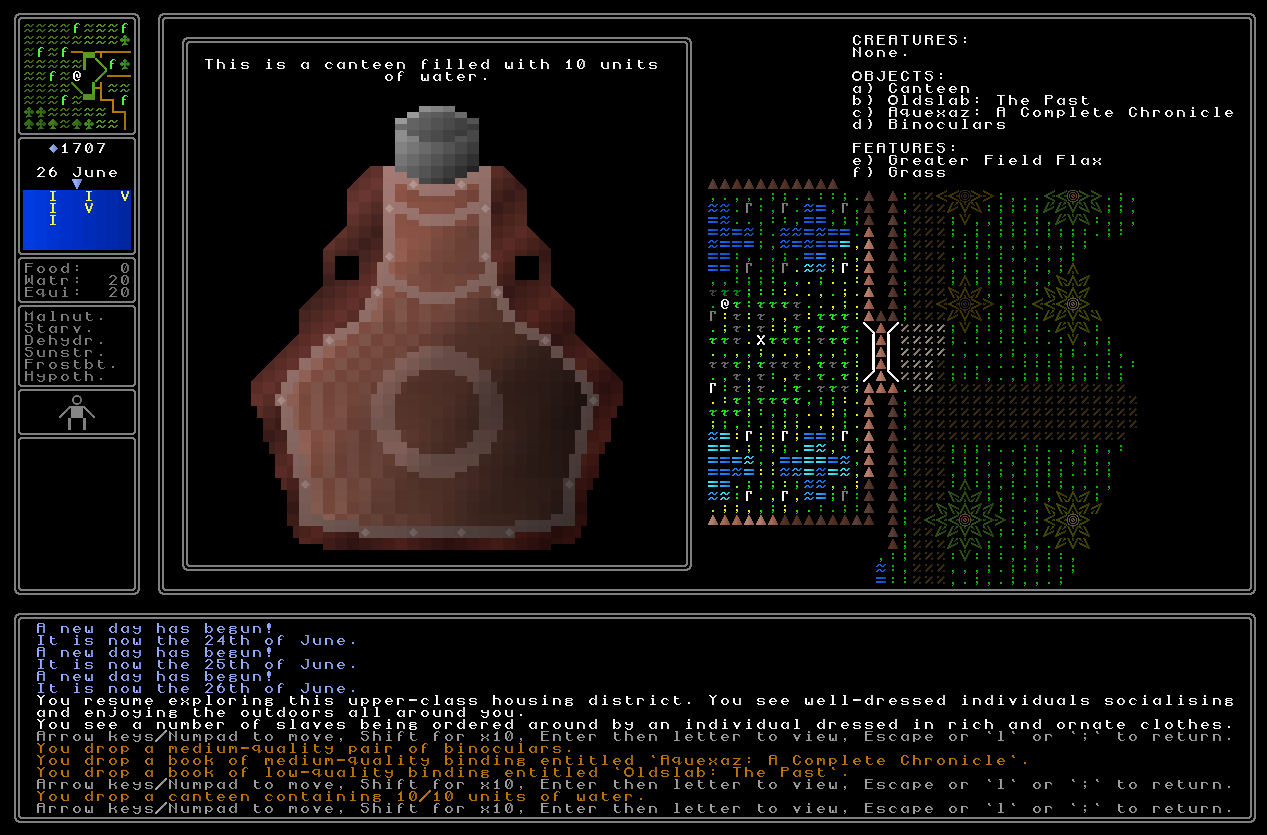
And then we get to the picking up part of the whole deal. Once you’re standing on an item you can press ‘,’ to pick it up (the standard key in various roguelikes of course) and if there are multiple items on a stack then the game will give you a list of what’s on the stack and the option to pick up whichever ones you want to pick up.
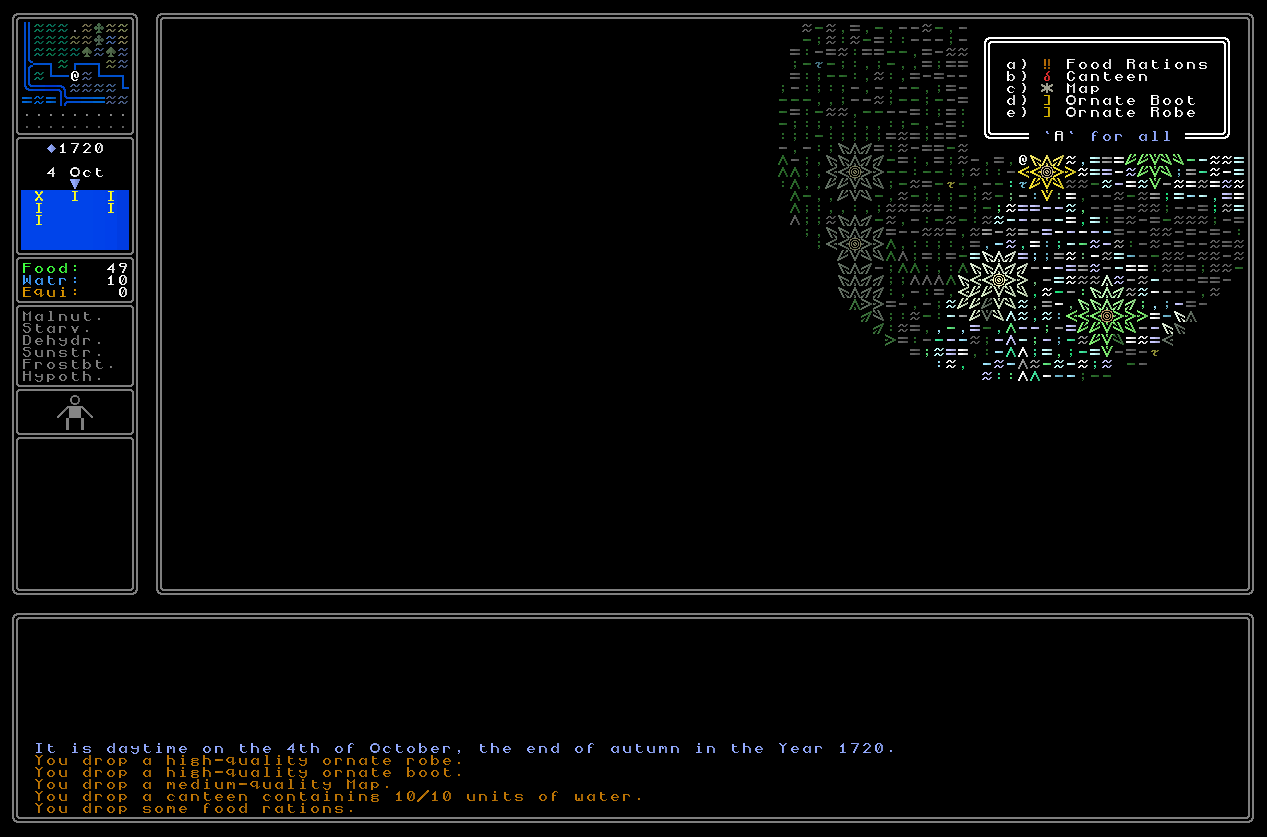
For now items will remain indefinitely where you drop them; this might change the future, or maybe you can acquire safe locations where you can place items, or more likely other ways to add items to the “storage” facilities you have in most nations… but for the time being, some essential bits of inventory management are now in place!
Presenting
You can now present an item! At the moment doing so presents it to everyone who is directly in the 3×3 grid around the player (i.e. a 3×3 grid centred on the player) and essentially involves you showing them the item and drawing attention to it. This can be done with any item and can get several hundred different responses depending on the item being shown, the type of person you are showing it to, and also the relationships that person might have to a nation, to a religion, and so forth. Presenting an item to someone might have a range of effects including getting a bit of information about that item or that person, highlighting a person’s possible interest in something, discovering some data about the national origin or the item or how people think about that item, or even more extreme outcomes – “presenting” a weapon to someone of high rank might be taken as an automatic threat and will result in the guards being set upon you, for example, while showing it to someone of low rank could also be seen as a threat, but one resulting in very different outcomes. A couple of these – such as combat-focused outcomes! – won’t be making it into 0.11, but all the different responses and sentences have now been programmed in (and there’s a colossal range). I’m really happy with some of the detail here such as showing someone a relic from their own religion will get an extremely positive response, showing a relic from their religion’s most hated religion (if there is one) will get a different response, while showing a relic from any other religion won’t get much of a response at all. Showing people books will yield responses that differ hugely based on the sort of book being shown and the person it is being shown to – a history book will probably interest a diplomat or a delegate in a democratic nation, while a book on animals or plants is going to interest someone from a nation with a very pastoral culture. This can be extended to pretty much every item in the game. As part of this the game makes a list of everyone you’re showing it to and then moves through them in order to let you know what they thought of the item being displayed – which is generally a lack of interest unless you’re showing them something special or something clearly related to them! In later releases though this will be a key way of making contact with important people, e.g. showing a particular item to a particular NPC might yield a particular hidden outcome. For now though, here’s a bunch of examples of the system in action:
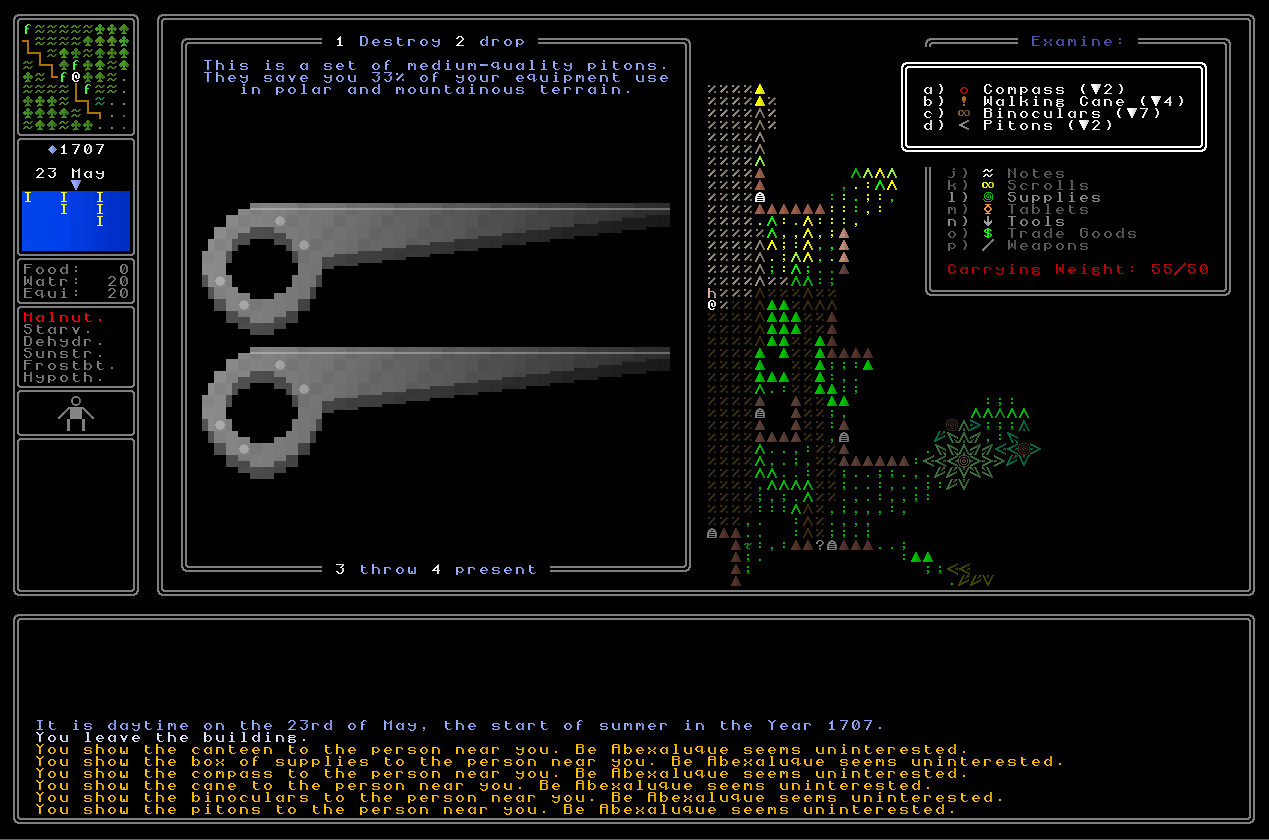
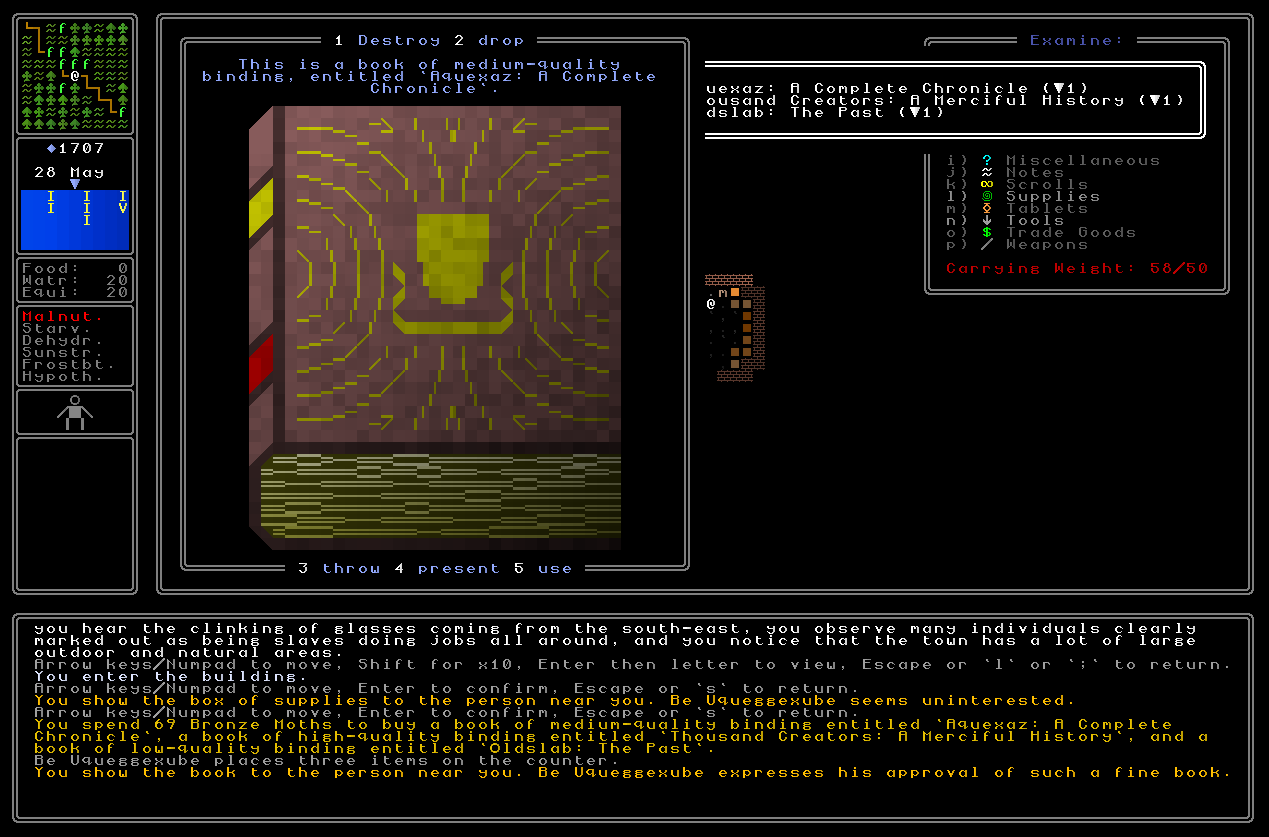
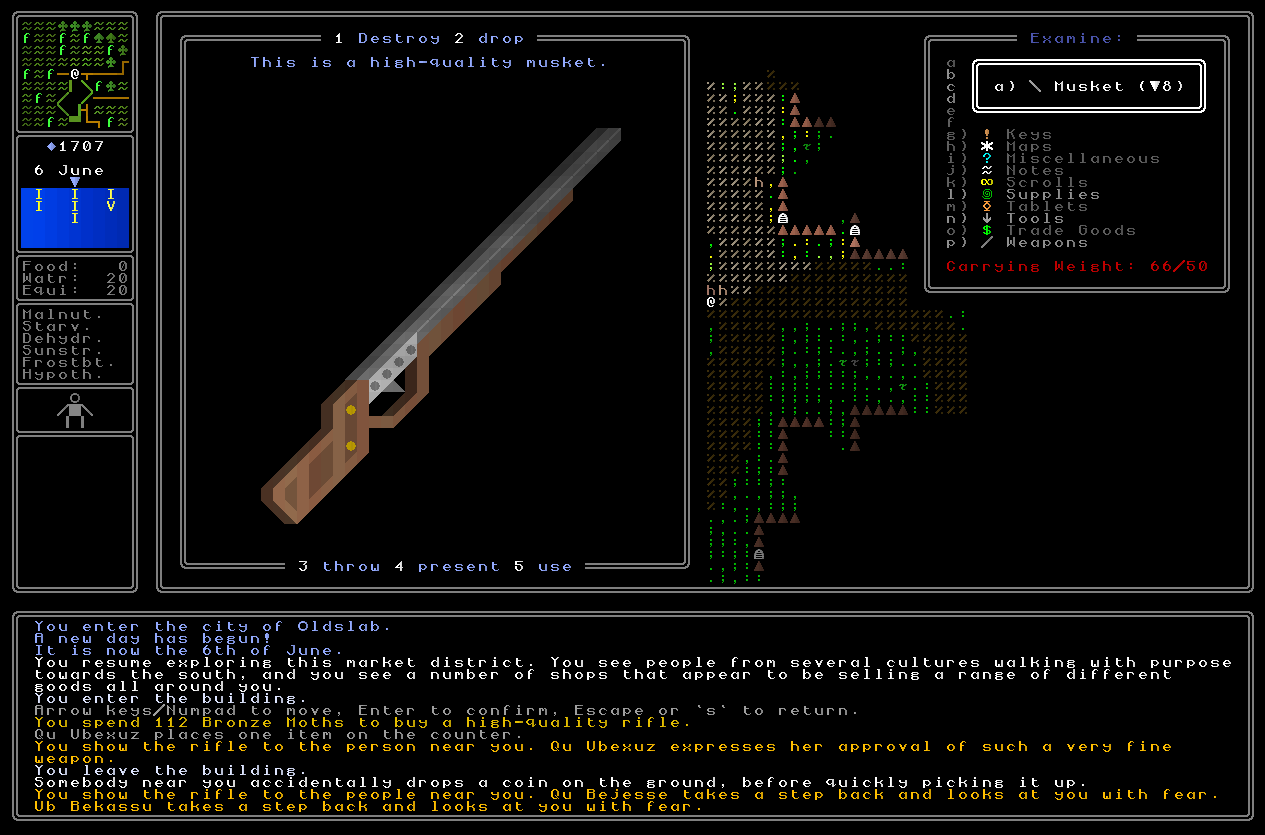
Destroying
You can also now destroy any item in your inventory. As with the previous ones, this will soon be possible by using the appropriate key when you’re just walking around the game world – ‘D’ in this case – but right now is done by going into your inventory, navigating to the item you want to destroy, and then pressing ‘1’ once you’re on the item. The idea behind destroying items is that very very rarely an item might have something valuable hidden inside it – another item, or a clue to something – and when the player is confident in sacrificing an item to get this valuable thing inside, it’s an option they can take. At the same time though it’s not something to be done without any good reason, as that’ll rapidly chew through your inventory. I think this is a kind of novel mechanic whereby you sacrifice one item for the possibility of another (ideally the player will know that Item X contains Thing Y before they do!) and in keeping with the game’s overall themes around secrets and hidden things.
Destroying an item takes time. Most item destructions only take a single turn – i.e. the game only increments the game state by one turn while you’re destroying the item – but some items take a bit longer. The largest and strongest items might take a dozen turns or more to destroy, the idea being that when you’re trying to destroy something very resilient – e.g. a piece of armour, or a stone religious relic – it’s going to take quite some effort to actually destroy the thing. One nice aspect of this is that I’ve gone through and given every single item in the game – now approaching one hundred! – a unique message for when you destroy it. Here, for example, are some of the messages for destroying the various different relic archetypes, and you’ll see that some of these take more turns than the default as well:
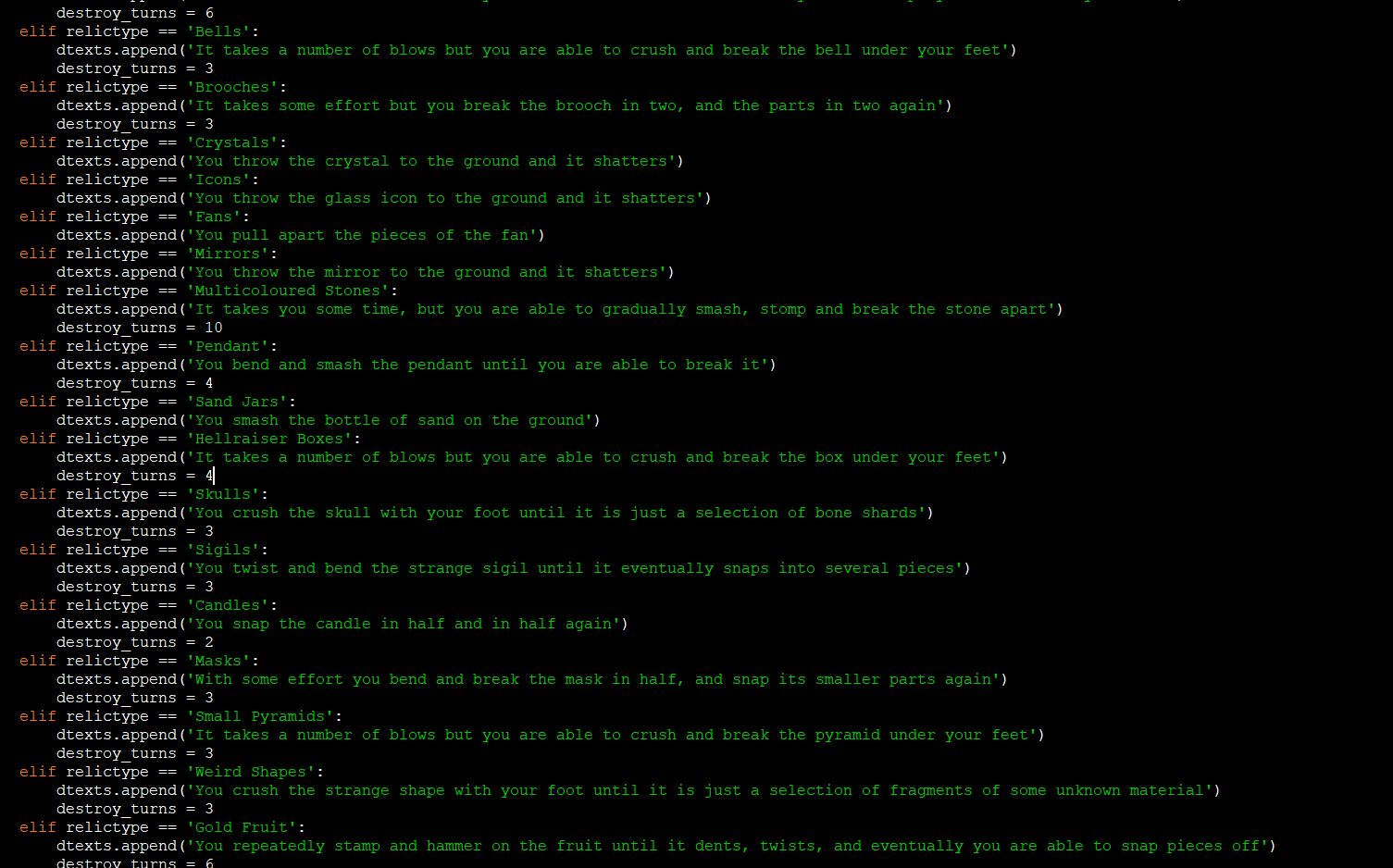
And so here are a few examples of the player destroying something, and finding – alas! – nothing inside:
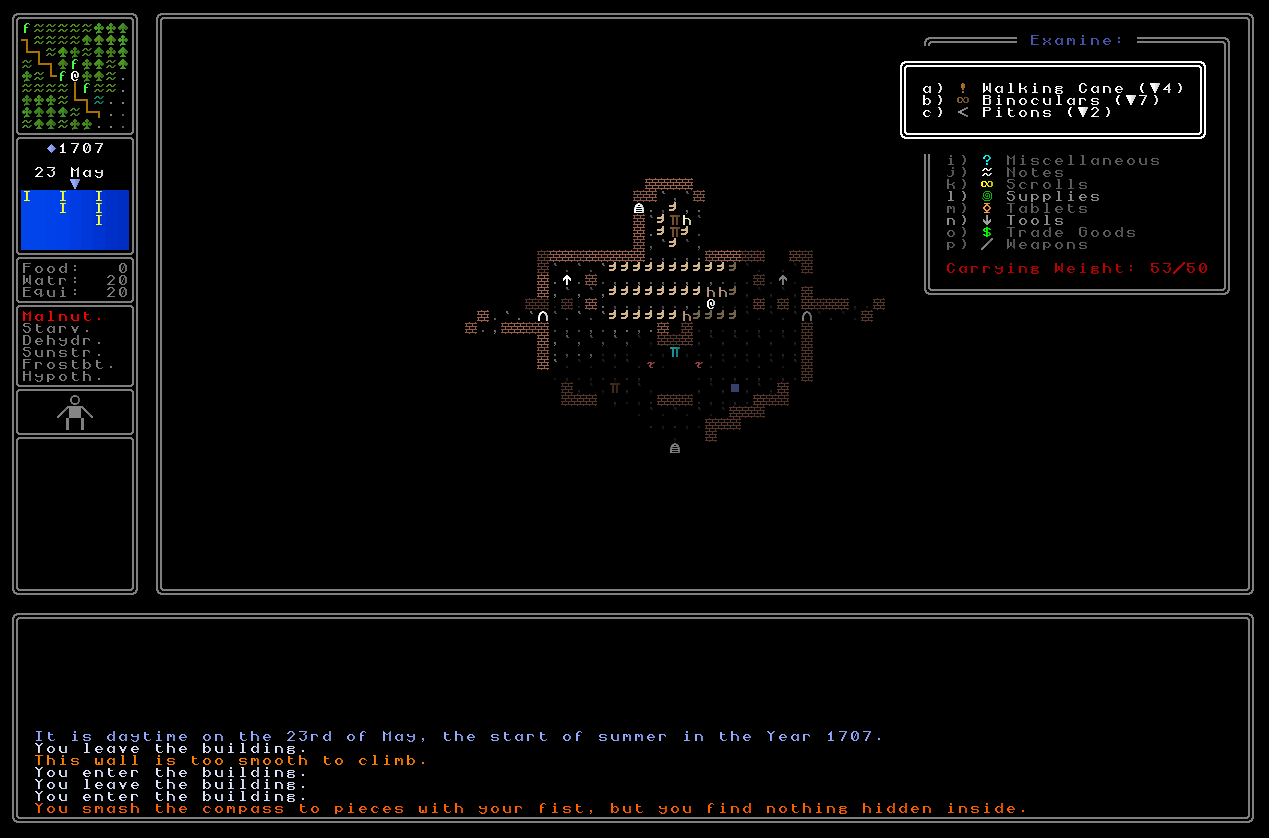
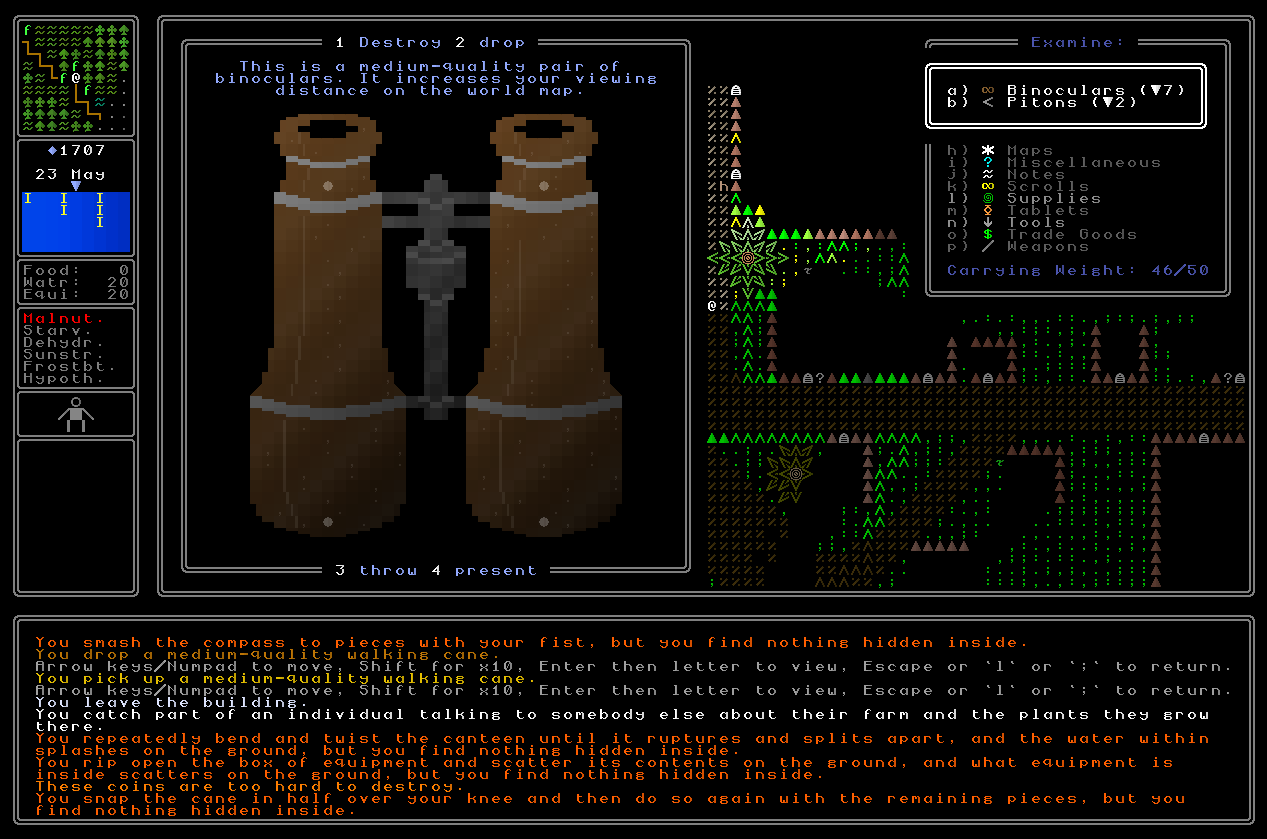
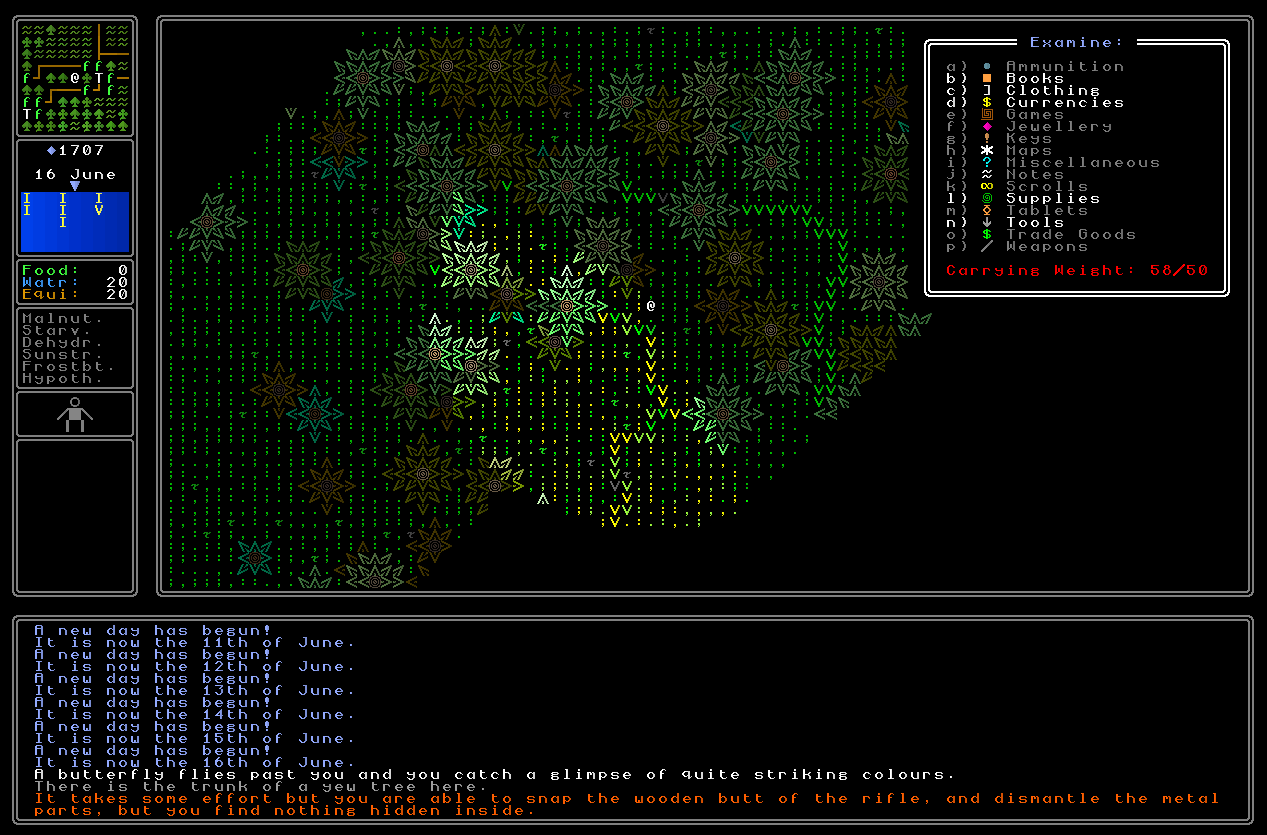
Guidebook update
I have updated the guidebook entry on “Trees and Plants” to be rather more up to date, with both information for this release and the near future as well! I’ve also removed the unwritten “Travel” entry – as most of that is covered in “Survival” and “Ships and Sailing” – as well as the “Resources” entry, as that isn’t really going anywhere. I’ve replaced these for now with placeholders for “Injury and Medicine” and “Astronomy”. The bottom part of this entry, meanwhile, will be updated once caves are implemented and I can say a little about plants and fungi in caves, but for now that final part remains blank.
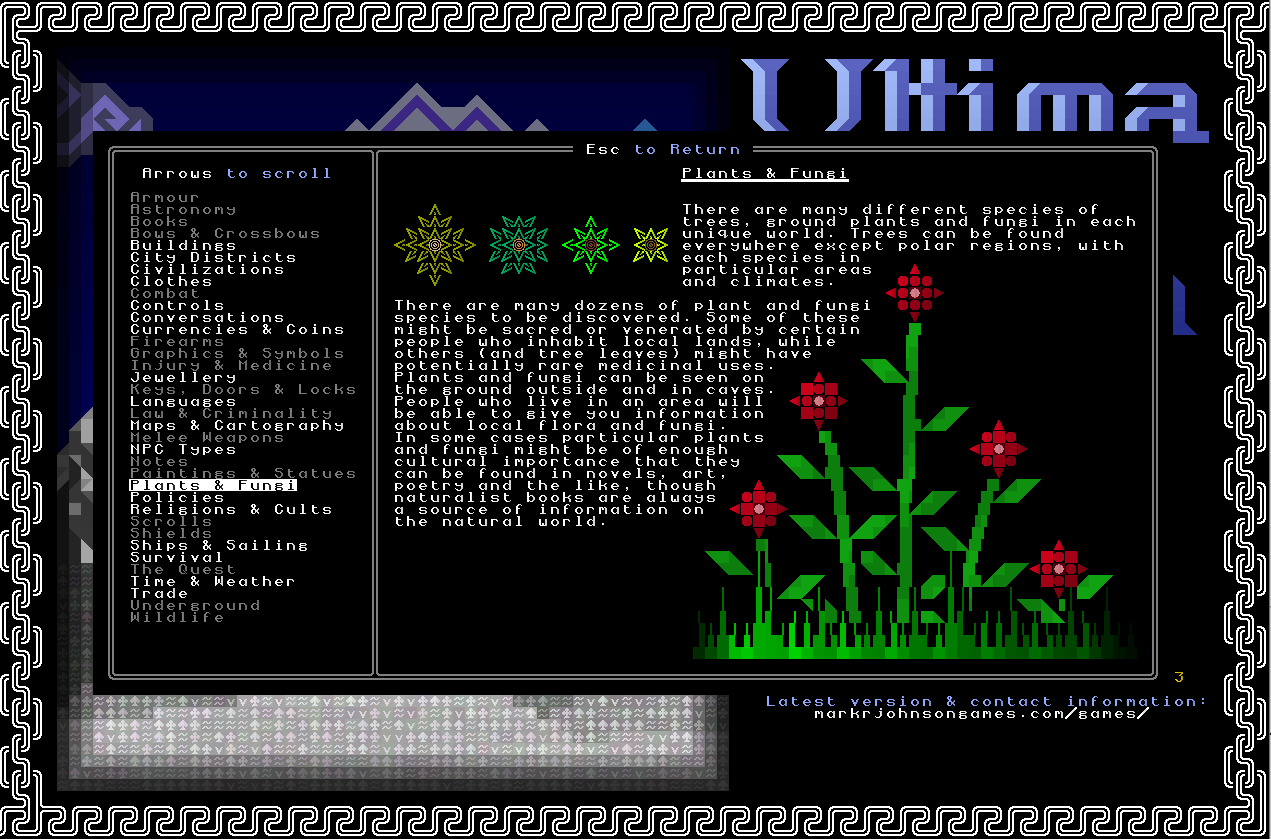
Bugs etc
- Fixed an issue in certain rare religious buildings containing reflecting pools in which a priest or worshipper would decide they really wanted to check out the pool, before then taking potentially entire seconds (of the game being frozen) to figure out where the pool actually is.
- Fixed a visual issue in the “Conversation” part of the guidebook, and a number of minor typos or graphical mistakes in several of the other entries.
- Fixed a problem with general / flavour text message sometimes failing to finish themselves with a ‘.’ or rarely an ‘!’ if appropriate.
- Altars now have a meaningfully different colour when in vision and outside of vision.
- One of the name generator archetypes which pairs an animal (e.g. Wolf, Fox, Deer) with a body part (e.g. Maw, Mane, Arm, Horn) can no longer, when creating an NPC’s name, pair the word for a certain desert-living humped ungulate with the word for one of the five digits on a foot. I confess though that it really, really made me laugh when I suddenly saw this name in the game while testing something else.
- Fixed a few visual bugs on the canteen management screen.
- Becoming overburdened no longer prevents you from picking anything up, but it will instead have effects (e.g. on speed etc -these are yet to be determined!).
- Fixed a crash bug where asking an NPC about leadership in a rare category of nations would be unable to generate a proper sentence.
- The colours of tropical ground are now properly different whether in vision or out of vision, rather than being almost identical and making it far less clear in these areas which way the player is actually facing.
What next?
Cracking along with progress here! I’ll be working in the next couple of weeks on more relic generation, beginning the rework of religions to make them far more complex and detailed and comparable to nations, and developing further the interaction options with / for items. More in a few weeks!
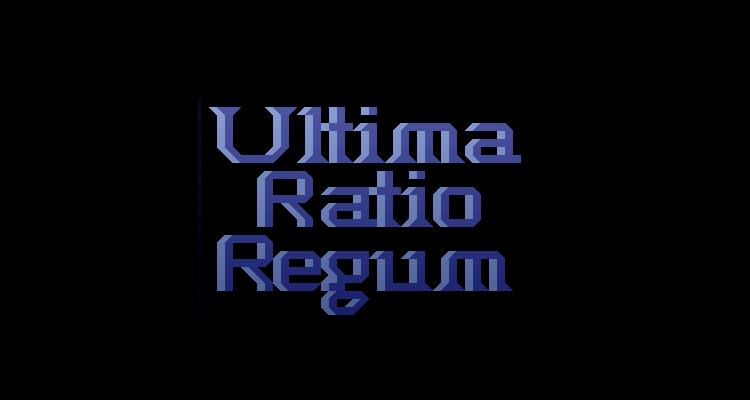
Finally, streaking in URR!!
😂
I like the format with the list at the start of the posts. I’m sure some might disagree on the color choices though. Why not use bold and italics? Bold for done, italics for in progress.
Hahaha, yes indeed! One of the great challenges with a project like this is that implementing one system so often speaks to the need to implement another system; if you can take off or destroy your clothes, there should be legal consequences for doing so, but then that requires the creation of law / punishment systems, but then THAT requires the creation of a combat system for a gladiatorial judicial nation… and so on. For this release I might just disable interactions for your clothes while leaving them for everything else?
Very exciting. I’ve been following since the very first release and you’ve come so far. Keep up the good work
Aw, thank you Rob, I really appreciate it! 🙂
It’s always exciting to see a URR dev update. I like the look of the relics, particularly the gears. Speaking of gears, you may have discussed this earlier, but if there are gears and muskets, what is the technology level in the game? Or is it variable between civilizations and/or during world generation? Or are there lost civilizations that had more advanced tech that you are searching for?
Thanks crowbar! It’s partially variable between civilizations, but something like very late medieval into Renaissance / Scientific Revolution. It’s a mix with the specific goal of both adding to world diversity and adding to gameplay choices and options when we come to things like combat and the like in the near future. I definitely have lost civilizations planned, though it’s hard to say what their technological level will have been just yet…